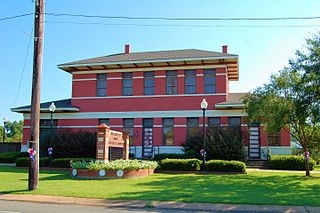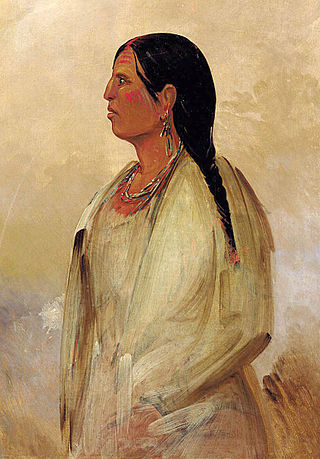Related Research Articles
Mobilian Jargon was a pidgin used as a lingua franca among Native American groups living along the Gulf of Mexico around the time of European settlement of the region. It was the main language among Native tribes in this area, mainly Louisiana. There is evidence indicating its existence as early as the late 17th to early 18th century. The Native groups that are said to have used it were the Alabama, Apalachee, Biloxi, Chacato, Pakana, Pascagoula, Taensa, Tunica, Caddo, Chickasaw, Houma, Choctaw, Chitimacha, Natchez, and Ofo. The name is thought to refer to the Mobile Indians of the central Gulf Coast, but did not originate from this group; Mobilian Jargon is linguistically and grammatically different from the language traditionally spoken by the Mobile Indians.

Avoyelles is a parish located in central eastern Louisiana on the Red River where it effectively becomes the Atchafalaya River and meets the Mississippi River. As of the 2020 census, the population was 39,693. The parish seat is Marksville. The parish was created in 1807, with the name deriving from the French name for the historic Avoyel people, one of the local Indian tribes at the time of European encounter.

Marksville is a small city in and the parish seat of Avoyelles Parish, Louisiana, United States. The population was 5,702 at the 2010 census, an increase of 165 over the 2000 tabulation of 5,537.

John Reed Swanton was an American anthropologist, folklorist, and linguist who worked with Native American peoples throughout the United States. Swanton achieved recognition in the fields of ethnology and ethnohistory. He is particularly noted for his work with indigenous peoples of the Southeast and Pacific Northwest.

The Tunica-Biloxi Indian Tribe, formerly known as the Tunica-Biloxi Indian Tribe of Louisiana, is a federally recognized tribe of primarily Tunica and Biloxi people, located in east central Louisiana. Descendants of Ofo (Siouan-speakers), Avoyel, and Choctaw are also enrolled in the tribe.

The Natchez are a Native American people who originally lived in the Natchez Bluffs area in the Lower Mississippi Valley, near the present-day city of Natchez, Mississippi, in the United States. They spoke a language with no known close relatives, although it may be very distantly related to the Muskogean languages of the Creek Confederacy. An early American geographer noted in his 1797 gazetteer that they were also known as the "Sun Set Indians".

Indigenous peoples of the Southeastern Woodlands, Southeastern cultures, or Southeast Indians are an ethnographic classification for Native Americans who have traditionally inhabited the area now part of the Southeastern United States and the northeastern border of Mexico, that share common cultural traits. This classification is a part of the Eastern Woodlands. The concept of a southeastern cultural region was developed by anthropologists, beginning with Otis Mason and Franz Boas in 1887. The boundaries of the region are defined more by shared cultural traits than by geographic distinctions. Because the cultures gradually instead of abruptly shift into Plains, Prairie, or Northeastern Woodlands cultures, scholars do not always agree on the exact limits of the Southeastern Woodland culture region. Shawnee, Powhatan, Waco, Tawakoni, Tonkawa, Karankawa, Quapaw, and Mosopelea are usually seen as marginally southeastern and their traditional lands represent the borders of the cultural region.
The Mosopelea, or Ofo, were a Siouan-speaking Native American people who historically lived near the upper Ohio River. In reaction to Iroquois Confederacy invasions to take control of hunting grounds in the late 17th century, they moved south to the lower Mississippi River. They finally settled in central Louisiana, where they assimilated with the Tunica and the Siouan-speaking Biloxi. They spoke the Ofo language, generally classified as a Siouan language.
The Taensa were a Native American people whose settlements at the time of European contact in the late 17th century were located in present-day Tensas Parish, Louisiana. The meaning of the name, which has the further spelling variants of Taenso, Tinsas, Tenza or Tinza, Tahensa or Takensa, and Tenisaw, is unknown. It is believed to be an autonym. The Taensa should not be confused with the Avoyel, known by the French as the petits Taensas, who were mentioned in writings by explorer Pierre Le Moyne d'Iberville in 1699. The Taensa are more closely related to the Natchez people and both are considered descendants of the late prehistoric Plaquemine culture.

The Biloxi tribe are Native Americans of the Siouan language family. They call themselves by the autonym Tanêks(a) in Siouan Biloxi language. When first encountered by Europeans in 1699, the Biloxi inhabited an area near the coast of the Gulf of Mexico near what is now the city of Biloxi, Mississippi. They were eventually forced west into Louisiana and eastern Texas. The Biloxi language--Tanêksąyaa ade--has been extinct since the 1930s, when the last known semi-speaker, Emma Jackson, died.
The Koroa were one of the groups of Indigenous people of the Southeastern Woodlands who lived in the Mississippi Valley before French colonization. The Koroa lived in the Yazoo River basin in present-day northwest Mississippi.

The Ofo language was a language spoken by the Ofo people, also called the Mosopelea, in what is now Ohio, along the Ohio River, until about 1673. The tribe moved south along the Mississippi River to Mississippi, near the Natchez people, and then to Louisiana, settling near the Tunica.

The Plaquemine culture was an archaeological culture centered on the Lower Mississippi River valley. It had a deep history in the area stretching back through the earlier Coles Creek and Troyville cultures to the Marksville culture. The Natchez and related Taensa peoples were their historic period descendants. The type site for the culture is the Medora site in Louisiana; while other examples include the Anna, Emerald, Holly Bluff, and Winterville sites in Mississippi.

The Opelousa were an Indigenous people of the Southeastern Woodlands in Louisiana. They lived near present-day Opelousas, Louisiana, west of the lower Mississippi River, in the 18th century. At various times, they allied with the neighboring Atakapa and Chitimacha peoples.

The Marksville culture was an archaeological culture in the lower Lower Mississippi valley, Yazoo valley, and Tensas valley areas of present-day Louisiana, Mississippi, Arkansas, and extended eastward along the Gulf Coast to the Mobile Bay area, from 100 BCE to 400 CE. This culture takes its name from the Marksville Prehistoric Indian Site in Avoyelles Parish, Louisiana. Marksville Culture was contemporaneous with the Hopewell cultures within present-day Ohio and Illinois. It evolved from the earlier Tchefuncte culture and into the Baytown and Troyville cultures, and later the Coles Creek and Plum Bayou cultures. It is considered ancestral to the historic Natchez and Taensa peoples.

The Tunica people are a group of linguistically and culturally related Native American tribes in the Mississippi River Valley, which include the Tunica ; the Yazoo; the Koroa ; and possibly the Tioux. They first encountered Europeans in 1541 – members of the Hernando de Soto expedition.
The Bayogoula were a Native American tribe from Louisiana in the southern United States.
The Taensa language was spoken by the Taensa people originally of northeastern Louisiana, and later with historical importance in Alabama. Though poorly documented, it was probably a dialect of the Natchez language. It was also the subject of controversy beginning in 1880–1882, when a French student published a grammar and sample texts of a language that he claimed to be Taensa, though it bore no resemblance to Natchez — these publications are generally considered to be a hoax and the language it described to be invented.

The Tunica treasure is a group of artifacts from the Tunica-Biloxi tribe discovered in the 1960s. Their discovery led to a protracted legal battle over their ownership, and the eventual passage of the Native American Graves Protection and Repatriation Act.
Horace Pierite Sr. was an American politician, farmer, trapper, and Native American leader.
References
- Swanton, John R. (1911). Indian Tribes of the Lower Mississippi Valley and Adjacent Coast of the Gulf of Mexico. Washington, DC: U.S. Government Printing Office.
